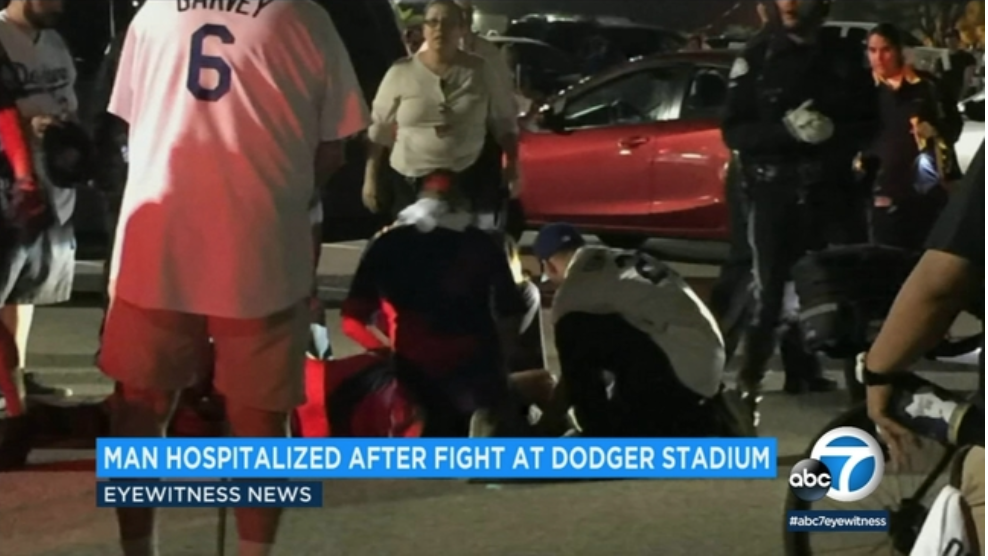CommentsDEEGAN ON LA-Dodger Stadium has many sounds -- the cheering of fans, the hawking of hot dogs by vendors, the dramatic exhortations from umpires on close calls, the crack of the bat and, more recently, the crack of a skull.
It’s early in the season, but maybe it’s time to start thinking about bringing along a first aid kit for the walk through the gauntlet of the parking lot after the game. This level of fan violence has not been seen since Opening Day in 2011, when Giants fan Bryan Stow was rendered brain damaged and disabled after he was attacked in the Dodger Stadium parking lot following the game.
In the case of the current tragedy, 45-year-old Rafael Reyna, was leaving the stadium after a Dodgers-Diamondbacks game a few weeks ago. He got involved in a verbal dispute with another fan that led to physical violence landing Renya on the ground, where he struck his head on the pavement. His wife, Christel, who was on the phone with him at the time and heard it all, compared the sound of her husband’s head hitting the ground to a “baseball bat hitting a ball.”
Renya is hospitalized, in a coma, in critical condition at LA County-USC Medical Center.
The Dodgers organization has batted this issue in a hardline drive directly to the other local boys in blue, the LAPD. The Dodgers told CityWatch that “Fan safety is our top priority, and we are committed to ensuring that Dodger Stadium is and continues to be a safe environment for all of our fans. It is unfortunate that a sudden altercation between two complete strangers resulted in one of them being injured. Because this matter is still under investigation by the Los Angeles Police Department, it would be inappropriate for us to comment further at this time.”
Los Angeles has not seen this sort of sports fan aggression since the Raiders called Los Angeles home and popularized themselves as the bad boys of football. They made it an iconic part of their identity that everyone understood and was prepared for.
Many baseball fans heading to a Dodgers’ game at Chavez Ravine can be expected to deck themselves out in supportive gear showing their allegiance to the team: a baseball cap with the team’s logo or a jersey with the number of a favorite player are standard. The onsite stadium store offers a wealth of Dodger-branded gear. Fans do not expect that dressing in Dodger blue is something that paints a target on their backs. But it does make them stand out -- and fans of visiting teams are able to identify them, sometimes verbally abusing or harassing them as opponents. Trash talk is part of sports. Fan violence is generally not.
The Dodgers present themselves as a family-friendly sports team, a wholesome entertainment enterprise. It’s hard to reconcile their goofy bobblehead program where fans receive commemorative mementos as they enter the stadium, with the sounds of sirens and the follow-up police investigations that can occur if fans are assaulted after vacating their seats and moving to the parking lots.
Violence in sports is nothing new. Football (soccer) fans in Europe are well known for their game-time rowdiness, their chanting and often, their violence. Think about the ancient chariot races, or the “sport” of gladiators fighting each other or even the lions in the Roman Coliseum, the Medieval “jousts” featuring mounted and armor-plated knights in combat.
Seen in context, sports can be a way to instill the values of teamwork, motivation, friendly competition and good sportsmanship. The more aggressive sports, those that involve “contact” or “collision,” require protective padding and helmets because of the inherent violence. But there is always a separation between those participating on the field and the spectators in the stands.
Fans walking to their cars in the Dodger Stadium parking lot do not dress for combat, contact or collision. Many are families who come to the ballpark to enjoy a fun experience, activities that include going to the field level up to two hours before the game to watch batting practice and maybe get autographs for the kids. Pre-adolescents can run the bases after Sunday games. Kids in the free “Junior Dodgers club” are randomly selected to join players on the field before the games. Everyone can go onto the field after a Friday evening game to watch the free fireworks display. Parents can get their kids a seat location wristband to be sure they can always find their way back to their seats. Kids that are bobblehead freaks can ride larger-than-life bobbleheads and play on structures they can climb on while their parents watch the game on nearby monitors.
The cocoon of Dodger Stadium may be one of the happiest places on earth during a game. None of this family fun the Dodgers offer includes training for hand-to-hand combat, or how to use evasive techniques against attackers in the parking lot. At least, not yet.
(Tim Deegan is a civic activist whose DEEGAN ON LA weekly column about city planning, new urbanism, the environment, and the homeless appear in CityWatch. Tim can be reached at [email protected].) Edited for CityWatch by Linda Abrams.














